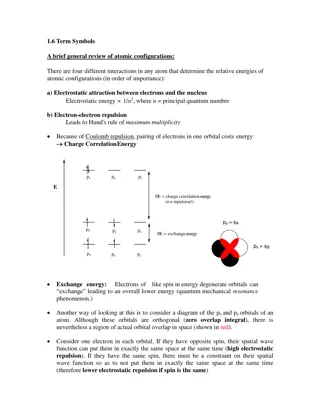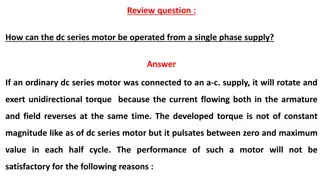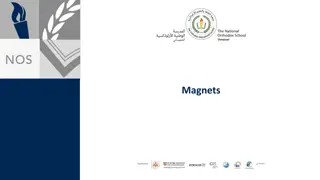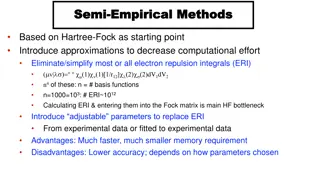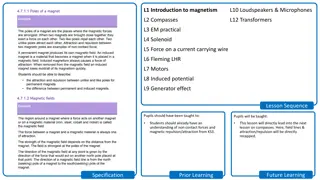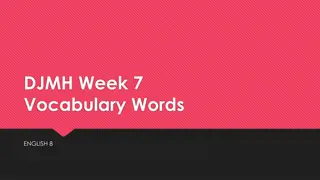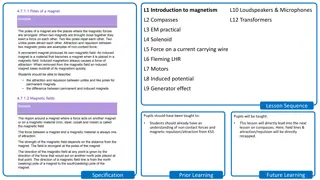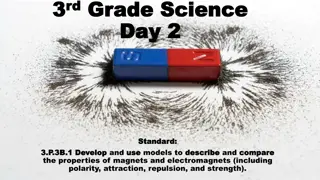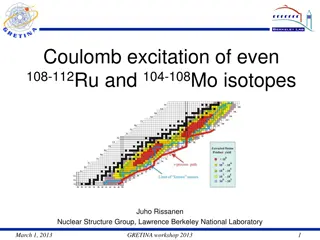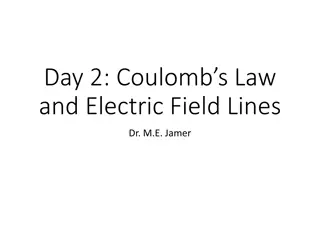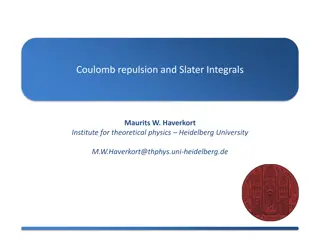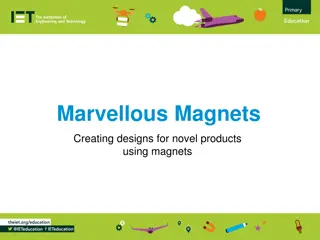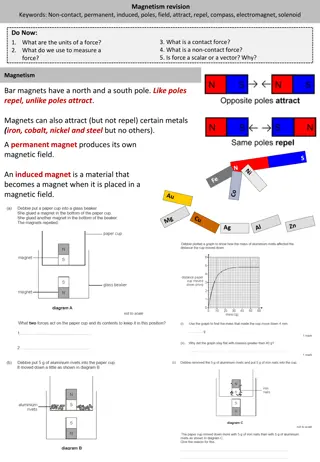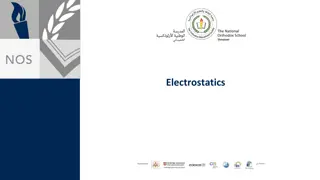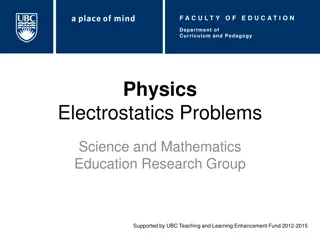Atomic Configurations and Term Symbols
The energy of atomic configurations is determined by electrostatic attraction between electrons and the nucleus, electron-electron repulsion, spin-orbit coupling, and spin-spin interactions. Term symbols in electronic spectroscopy specify atomic states using quantum numbers. Hund's rule and the Paul
8 views • 12 slides
Operating a DC Series Motor from a Single Phase Supply
Connecting a DC series motor to an AC supply results in pulsating torque due to reversed current flow. This setup leads to inefficiencies and challenges such as eddy current losses and poor power factor. To improve performance, modifications like laminating core structures, using compensated winding
1 views • 23 slides
Magnets: Properties, Attraction, and Repulsion
Explore the fascinating world of magnets through a series of True or False questions, visual aids, and practical examples. Learn about magnetic materials, the Earth's magnetic field, and the behavior of magnets when interacting with different objects. Test your knowledge with fun activities and enha
1 views • 10 slides
Magnets and Magnetic Fields
Explore the fascinating world of magnets and magnetic materials. Discover how magnets have two poles, North and South, and how they interact with each other. Learn about magnetic materials like iron, cobalt, and nickel, and understand the concept of magnetizing and demagnetizing. Dive into the magne
1 views • 15 slides
Overview of Semi-Empirical Methods Based on Hartree-Fock
Semi-empirical methods derived from Hartree-Fock theory aim to reduce computational effort by approximating or eliminating electron repulsion integrals. Strategies include introducing adjustable parameters to replace ERI calculations and utilizing zero differential overlap methods like CNDO, INDO, N
5 views • 11 slides
Magnetism: Introduction to Key Concepts
Delve into the fundamentals of magnetism with a focus on magnets, magnetic fields, and induced vs. permanent magnets. Explore the concepts of attraction, repulsion, magnetic materials, and the behavior of different metals in the presence of magnets. This lesson sets the foundation for a deeper under
1 views • 19 slides
Allylic Strain in Organic Chemistry
Allylic strain refers to the unfavorable nonbonding repulsion caused by certain substituents in the allylic position of a molecule. This strain can impact reaction outcomes and diastereoselectivity, as seen in examples like Diels-Alder and hydroboration oxidation reactions. Proper understanding and
2 views • 9 slides
Week 7 Vocabulary Words - English 8
Explore the vocabulary words for Week 7 in English 8, including definitions and contextual sentences. Enhance your understanding of words like "repulsion," "mien," "disconsolate," "abject," "traverse," "explicit," "doggedly," "amply," "amiss," and "lamentation" through visual aids and examples.
0 views • 11 slides
Magnetism: Introduction and Key Concepts
Delve into the fascinating world of magnetism in this lesson, covering topics such as compasses, solenoids, motors, and generators. Explore the basics of magnetic fields, attraction and repulsion, and the difference between permanent and induced magnets. Strengthen your understanding of magnetism th
0 views • 18 slides
Magnets and Electromagnets in 3rd Grade Science
Explore the unique properties of magnets and electromagnets in this 3rd Grade Science lesson. Learn about polarity, attraction, repulsion, and strength. Discover how magnets work, the importance of poles, and the behavior of like and unlike poles. Dive into the world of magnets to develop models and
1 views • 16 slides
Coulomb Excitation Studies of Neutron-Rich Ru and Mo Isotopes
Workshop presentation on using GRETINA, CHICO, and CARIBU for Coulomb excitation studies of even Ru and Mo isotopes, exploring shape evolution through systematic studies and experimental limitations like beam intensity and purity. Analysis includes gamma intensities, level schemes, and nuclear reori
1 views • 11 slides
Electricity and Charges: A Teaching Resource
Explore the fascinating world of electricity, charges, electrons, voltage, current, series, parallel circuits, and resistance through engaging slides designed to complement worksheets. Discover hands-on experiments that illustrate concepts like rubbing plastic to create static charges, observing eff
1 views • 47 slides
Coulomb's Law in Electrostatic Interactions
Coulomb's Law states that charges with the same sign repel each other, while charges with opposite signs attract. The strength of the electrostatic force between two particles is directly related to the amount of charge each possesses and inversely proportional to the square of the distance between
1 views • 24 slides
Coulomb's Law and Electric Field Lines
Learn about Coulomb's Law, electric field lines, and how charges interact without touching. Explore the concept of electric fields and how to calculate them, along with understanding dipole configurations and similar charge interactions through informative visuals and explanations.
0 views • 11 slides
Coulomb Interaction in Many-Particle Hamiltonian
Explore the treatment of Coulomb interaction in a many-particle Hamiltonian, where careful integration is crucial due to divergence issues. Learn about solving the Coulomb Hamiltonian with Slater integrals and expanding the operator on spherical harmonics for analytical solutions. Discover the signi
0 views • 15 slides
Coulomb Repulsion and Slater Integrals
Dive into the intricate world of Coulomb repulsion and Slater integrals, essential concepts in quantum physics. Explore the challenges posed by the diverging Coulomb integral and the complex calculations required to evaluate these interactions. Discover how Slater integrals play a crucial role in cr
1 views • 14 slides
Electrostatic Properties of Polyelectrolyte Solutions for DNA Molecules
Double-stranded DNA molecules exhibit repulsion due to their linear charge distribution, which can be mitigated by positively charged counter-ions. The Bjerrum length and Manning structural parameter play crucial roles in defining charge density. Electrostatic repulsion terms and calculations involv
1 views • 27 slides
Exploring the World of Magnets: Designs, Properties, and Applications
Delve into the fascinating realm of magnets, learning about their composition, attraction and repulsion properties, as well as their diverse applications in various products. Discover how magnets are used in innovative designs and get inspired to create your own magnetic products.
2 views • 7 slides
Magnetism: Concepts and Applications
Understanding magnetism involves learning about magnetic fields, poles, attraction, repulsion, and electromagnetism. Explore how magnets work, magnetic fields interact, and electromagnets are created. Dive into the properties of permanent and induced magnets while uncovering the magic of compasses a
2 views • 4 slides
Static Electricity and Electrostatics
Static electricity is a result of electric charge buildup on insulating materials due to friction, causing electrons to transfer and create a charge difference. This can lead to phenomena like a balloon sticking to a wall. The origin of static charge lies in the electrons and protons within atoms, w
1 views • 9 slides
Electrostatics Problems
Electrostatics problems in physics education related to electric field strength, charge interactions, and Coulomb's law. Solve and understand questions on changes in field strength, charge distances, and Coulomb's law implications.
0 views • 22 slides
Introduction to Coulomb's Law in Electrostatics
Discover the principles of electrostatics through Coulomb's Law. Learn about the relationship between charges, forces, and distances in electrical interactions. Explore examples illustrating the attractive and repulsive forces between charged objects.
0 views • 8 slides
Topic: Molecular Shape
Explore the relationship between Lewis structures and molecular shapes, with a focus on factors influencing molecular geometry such as electron pairs and atoms around the central atom. Utilize VSEPR theory to predict shapes based on electron-pair repulsion. Understand how different atom arrangements
0 views • 22 slides
Charge, Coulomb's Law, and Electric Fields
Charge is a fundamental quantity in nature, with electrons and protons having positive and negative charges. Coulomb's Law explains how charges interact, while electric field diagrams illustrate the concept of electric fields. The force between charges can be calculated using the formula, F = qE.
0 views • 7 slides
Introduction to Volume Rendering Techniques
This content covers various techniques used in volume rendering, including implicit functions, voxels, isosurface rendering, marching cubes, direct volume rendering, transfer functions, and more. It explores concepts such as scalar fields, sampled volumes, point repulsion, and decomposition of volum
1 views • 19 slides
Magnetism
Magnetism is a fascinating natural phenomenon that involves the interaction between magnetic materials. Learn about the properties of magnets, their effects, and how they are used in everyday life. Explore the concept of magnetic fields, different types of magnets, and the significance of Earth's ma
1 views • 9 slides
Electric Motors: Conversion and Function
An electric motor is a device that converts electricity into motion through the interaction of magnetic fields. By utilizing the principles of attraction and repulsion between different poles, electric current flowing through coils generates a magnetic field that interacts with a permanent magnet, c
0 views • 12 slides
Coulomb’s Law and the Electric Field
In this lecture, Michael Fowler explains Coulomb's Law and the Electric Field, discussing the invention of the electroscope, methods of charging it, and the unit of charge. The inverse square law relationship between charges, the measurement apparatus used by Coulomb, and the numerical values associ
0 views • 22 slides
Electric Fields, Conductors, and Coulomb's Law Overview
key concepts in physics including electric fields, conductors, motion of charged particles, electric dipoles, and Coulomb's Law. Get details about homework submissions, upcoming exams, and extra credit projects. Understand the comparison between Coulomb force and gravitational force in different sce
0 views • 13 slides
Exploring the Fascinating World of Magnetism
Discover the rich history and scientific principles behind magnetism, from ancient civilizations harnessing its power to modern-day understanding of magnetic phenomena. Learn about magnetic materials, poles, and the captivating forces of attraction and repulsion. Uncover the secrets of magnetism and
0 views • 56 slides
Physics 1441 Lecture on Static Electricity and Coulomb's Law
Explore the basics of static electricity, charge conservation, Coulomb's Law, and more in this Physics 1441 lecture. Learn about insulators, conductors, induced charge, and the history of physics. Homework deadlines and exam rules are also highlighted.
0 views • 21 slides
Exploring Magnets, Electricity, Circuits, and Inventors
Discover the fascinating world of magnets, electricity, circuits, and inventors through engaging visuals and informative images. Learn about the characteristics of magnets, magnetism, the relationship between magnetism and electricity, conductors, insulators, and more. Dive into the science of attra
0 views • 51 slides
Understanding Coulomb's Law and Electric Dipoles in Physics 102 Lecture
Explore the fundamentals of Coulomb's Law and electric dipoles in Physics 102 Lecture. Learn about molecular interactions, polar vs. nonpolar molecules, hydrophilic vs hydrophobic properties, and more. Practice using Coulomb's Law, vector addition, and apply these concepts to understand the behavior
0 views • 23 slides
Applying Coulomb's Law in Physics Lab with PASCO Capstone
Explore the application of Coulomb's Law in a physics lab setting using PASCO Capstone for electrical and magnetic measurements. Learn how to perform the experiments, analyze the data, and generate a laboratory report. Dive into hands-on activities such as tape charge experiments and utilizing Capst
0 views • 9 slides
Understanding Hubbard Model Analysis and Its Extensions in Solid-State Physics
Explore the intricacies of the Hubbard model through an analysis of solutions for a 2-site system and its Hartree-Fock extension to a linear chain. Delve into the Hubbard Hamiltonian, possible configurations on a single site, and the implications of electron hopping and repulsion. Discover the matri
0 views • 33 slides
Understanding Magnetic Forces and Electric Motors
Explore the concept of magnetic forces on current-carrying conductors, the workings of electric motors, and the fundamentals of electromagnetism. Learn about Fleming's left-hand rule, the directional relationship between current, magnetic field, and force, as well as the motion of current-carrying l
0 views • 20 slides
Understanding Coulomb's Law in Physics
Learn about Coulomb's Law, a fundamental principle in physics describing the electrostatic interaction between charged particles. Discover the law's definition, importance, mathematical formula, and explanation with examples and illustrations. Explore the significance of the constant of proportional
0 views • 12 slides
Understanding Coulomb's Law and Electrostatic Fields
Explore Coulomb's Law, Poisson's Equations, Laplace's Equations, Scalar Potentials, Point Charges, and more in the field of electrostatics. Learn about the relationship between electric fields, potentials, charge distributions, and the principles governing electrostatic interactions.
0 views • 9 slides
Understanding Magnets and Their Properties
Discover the fascinating world of magnets, including how they attract and repel, the elements involved like iron, cobalt, and nickel, and the concept of magnetic force. Explore the characteristics of steel and how it relates to magnets. Unveil the science behind magnetic attraction and repulsion, de
0 views • 36 slides
Understanding Motion in the Coulomb Field: Relativistic Perspectives
Explore the transition from non-relativistic to relativistic situations in the Coulomb field, examining conditions where a particle can or cannot fall to the center based on the relative mass, total energy, and angular momentum. Discover the implications of the Hamilton-Jacobi equation and the power
0 views • 12 slides
